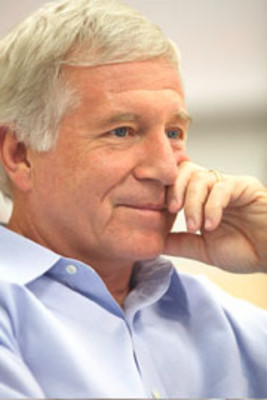Sun (power) will rise tomorrow
The internal combustion-engine and coal-fired power plants will become as outmoded as the horse and buggy -- if the country embraces available technology and harnesses the power of the sun.
That's the assessment of David Mills, a doctoral-degreed physicist and chairman of solar-energy developer Ausra.
Mills presented a scientific paper on the subject Wednesday at South Point during the 14th biennial CSP SolarPaces Symposium, a program of the International Energy Agency.
"An almost complete elimination of both fossil-fueled generation and oil usage for transportation in the U.S.A. appears to be technically feasible," Mills said in the paper. "This paper presents solar electricity as the most likely means to nearly eliminate contributions to global warming from electricity generation by midcentury."
Scientists believe that carbon dioxide from coal- and gas-fired power plants and gasoline-powered cars leads to global warming.
Mills envisions the nation replacing coal- and gas-fired power plants with clean solar thermal plants that provide electricity for residential, commercial and industrial customers. Also, Mills said, plug-in electric cars could eliminate the need for gasoline-burning vehicles. Drivers could either recharge their batteries overnight or use quick-charge technology.
Mills is chairman, founder and chief scientific officer of Ausra, the Palo Alto, Calif.-based company that is installing a solar thermal assembly plant in Las Vegas. The company also is developing a 177-megawatt solar thermal power plant in California for Pacific Gas & Electric.
Bob Boehm, distinguished professor of engineering at the University of Nevada, Las Vegas and director of the Center for Energy Research, mostly agreed with Mills' conclusions, although he had reservations.
Nevada and other Southwestern states have some of the world's best solar resources, Boehm said. He wasn't sure whether power from solar thermal was feasible in states like Washington and Maine, but Boehm suggested Northern states could use wind power.
Thermal storage is the key to solar power's promise, Boehm said, because it will allow solar thermal power plants to store heat and continue to generate electricity after the sun sets. Mills' paper talks about thermal storage lasting 16 hours, making solar power virtually available around the clock.
Boehm said he didn't have information on Ausra's research into thermal storage using water and couldn't predict whether Ausra would become a solar thermal leader.
"But that's the direction things have to go," Boehm said.
Critics often question renewable energy's cost. But Mills said solar thermal power is becoming competitively priced with coal-fired plants when solar plants are built in the 500 megawatt to 1 gigawatt size. A gigawatt is a billion watts.
Mills studied electrical power-use patterns in California and Texas, concluding that solar power generation fits well with those states' daily and seasonal energy use patterns.
For example, electrical demand typically peaks in the summer when solar thermal plants are efficient in generating electricity.
Mills suggested that the country could convert cars and trucks to electric power and get the power from solar plants built over the next 30 years.
"Then, the annual generation replacement cost would be between U.S. $24 billion and U.S. $52 billion," he said.
For each year, however, the country would save $48 billion in imported oil, he said.
With oil going for $100 a barrel, the payback for going solar would come in 18 months to three years, Mills said. (Light, sweet crude for April delivery fell 32 cents Friday to settle at $105.15 a barrel on the New York Mercantile Exchange.)
Another benefit would be less pollution from fossil fuels such as gasoline, natural gas and coal, he said.
Boehm said the United States led the world in renewable-energy technology several years ago. Now, the United States depends on Asian and European companies for most renewable technology.
"The solar thermal industry is our last chance to be in the (renewable) market," Boehm said. "Otherwise, we're going to buying stuff from overseas."
Contact reporter John G. Edwards at jedwards@reviewjournal.com or (702) 383-0420.






















